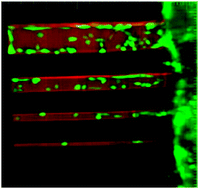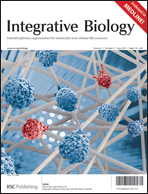In order to independently study the numerous variables that influence cell movement, it will be necessary to employ novel tools and materials that allow for exquisite control of the cellular microenvironment. In this work, we have applied advanced 3D micropatterning technology, known as two-photon laser scanning lithography (TP-LSL), to poly(ethylene glycol) (PEG) hydrogels modified with bioactive peptides in order to fabricate precisely designed microenvironments to guide and quantitatively investigate cell migration. Specifically, TP-LSL was used to fabricate cell adhesive PEG-RGDS micropatterns on the surface of non-degradable PEG-based hydrogels (2D) and in the interior of proteolytically degradable PEG-based hydrogels (3D). HT1080 cell migration was guided down these adhesive micropatterns in both 2D and 3D, as observed via time-lapse microscopy. Differences in cell speed, cell persistence, and cell shape were observed based on variation of adhesive ligand, hydrogel composition, and patterned area for both 2D and 3D migration. Results indicated that HT1080s migrate faster and with lower persistence on 2D surfaces, while HT1080s migrating in 3D were smaller and more elongated. Further, cell migration was shown to have a biphasic dependence on PEG-RGDS concentration and cells moving within PEG-RGDS micropatterns were seen to move faster and with more persistence over time. Importantly, the work presented here begins to elucidate the multiple complex factors involved in cell migration, with typical confounding factors being independently controlled. The development of this unique platform will allow researchers to probe how cells behave within increasingly complex 3D microenvironments that begin to mimic specifically chosen aspects of the in vivo landscape.

You have access to this article
 Please wait while we load your content...
Something went wrong. Try again?
Please wait while we load your content...
Something went wrong. Try again?


 Please wait while we load your content...
Please wait while we load your content...